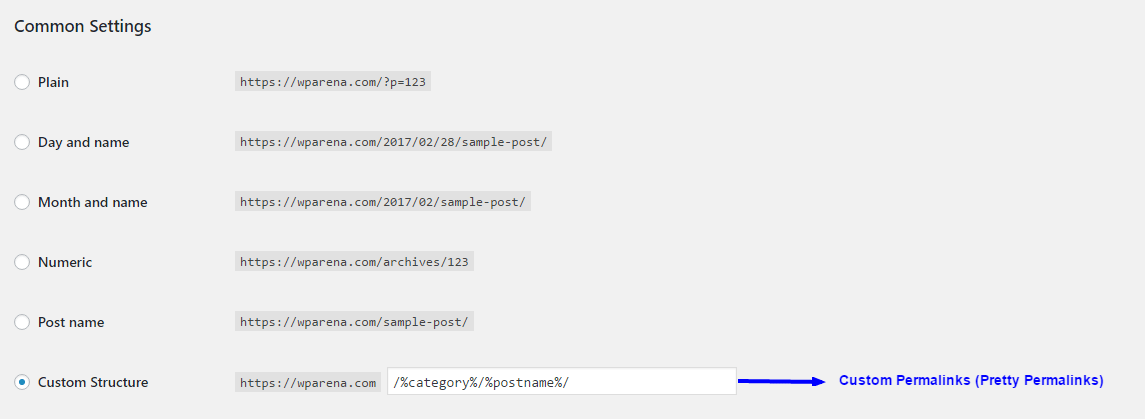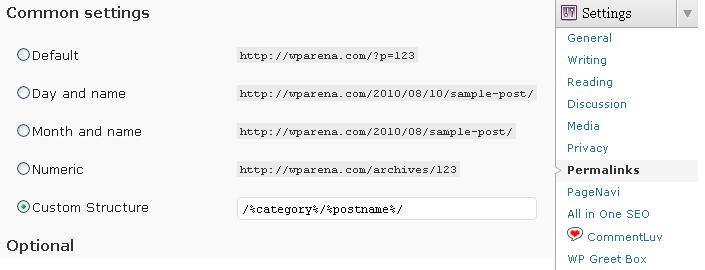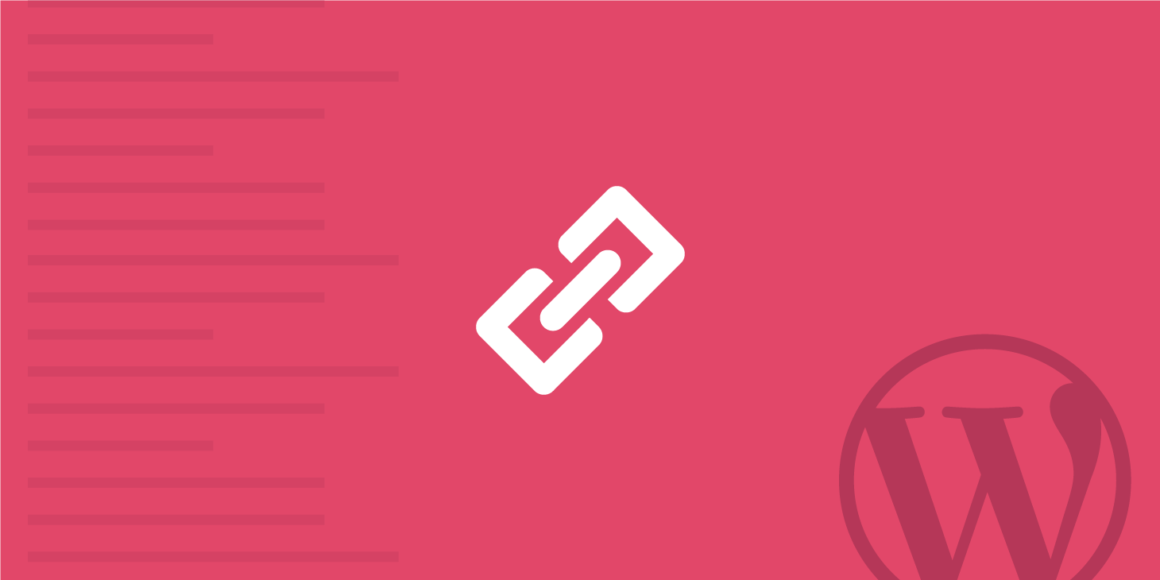What are Permalinks?
Permalinks, a term for “Permanent Links,” are the URLs used in WordPress to access single pages, posts, and archives on your website. For example, permalinks of a WordPress Blog are permanent and will never change until we do it intentionally from the Backend of a WordPress site.
It is vital to understand Permalinks, as it directly impacts the site users and search engines. A Well-organized permalinks structure is essential in organizing the content of a website more efficiently as well as in attracting visitors and search engines. It will also help in navigating different pages on a site.
In this WordPress Permalinks Structure guide, we will learn the basics of permalinks, how permalinks work in WordPress and how to manage permalinks for better results, and some other tips and advanced settings. We will also have a look at making Permalinks Search engine friendly and how to select a Permalink structure for your website.
Permalinks in WordPress
Permalinks in WordPress can be handled from the Backend easily. You have to navigate to the Settings >> Permalinks in the left-hand-side menu of the WordPress dashboard. WordPress Permalinks are usually classified into different types. Here we will try to explain them.
- Ugly Permalinks: (Default WordPress Permalink Structure which contains Post ID (http://www.example.com/?p=2017)
- Pretty Permalinks: (Custom Permalinks which contains human-readable words like (http://www.example.com/%category%/%postname%/)
1. Ugly Permalinks
Ugly permalinks are the default WordPress Permalinks settings activated when installing a WordPress on your server. This is the most annoying permalinks structure and not SEO Friendly. Almost all the web developers and bloggers switch to Pretty Permalinks right after installing WordPress. Ugly Permalinks are usually not much readable as in the image below.
An ugly permalink usually contains numbers instead of words. The default WordPress permalinks are considered ugly because it uses Post ID in the URL, as you can see below. This is not an SEO Friendly Permalink structure.
https://wparena.com/?p=1232. Custom Permalinks (Pretty Permalinks) in WordPress
After installing WordPress, the first thing to do is create a custom Permalink structure. WordPress allows you to generate permalinks (permanent URIs) on your blog, which appear as though each of your posts is an individual static page on your site rather than the productive output of a database-driven website. A custom Permalink structure will make your blog more SEO friendly and turn those ugly URL’s into Google bait!

Instead of a URL to one of your stories looking like
https://wparena.com/?p=123, whereas p = "you post id"WordPress can use something like this link:
http://wparena.com/category-name/your-Posttittle/Follow these simple steps for a more SEO-friendly WordPress blog URL structure.
From within the WordPress dashboard, click on Settings, then Permalinks.
You will then see the following options:
Default
» https:// wparena.com/?p=123Date and name based
» https:// wparena.com/2007/05/29/sample-post/Numeric
» https:// wparena.com/archives/123Custom, specify below
» Custom structurePaste the following code in the Custom structure box:
/%category%/%postname%This is the custom Permalink structure I use and recommend. It will change the post page URL to
https:// wparena.com/category/PostTitleIf your post title is too long you should create a post slug when writing your post.
If the title of your post is too long, you can shorten it in the write post screen using a shorter but relevant Post Slug found on the right side of the Write Post box just under the Post Password box.
Warning – If you have an existing WordPress blog changing the URL structure will lose many of your incoming links. Here is an excellent tutorial if you want to change your Permalink structure on an existing blog.
With an excellent SEO-friendly category and post title, your chances of ranking higher in the search engines will increase.
– Shorten WordPress Custom Permalinks
If using categories and postname in your Permalinks structure, WordPress, by default, will use the name of the category or categories and the title of your post as part of the post’s URL or The URL of a post using /%category%/%postname% as a Permalink structure will look like this:
http://www.YourSite.com/blog/ParentCategory/SubCategory/TitleOfPostAs you can see, this gets long and ugly, but there are ways to shorten this with a little careful consideration when creating new categories and using the Permalink box above the post editor.
When writing a post, look for the Permalink edit button just under the post title to shorten the Permalink. Click it to shorten the trailing end of the URL. For example – if your post title is “How To Work At Home While Drinking Beer,” put this in the Post Slug box: work at home beer. Try to make it as short as possible while maintaining the top keywords in the post slug.
To add a new child category, go to Posts, Categories, and add a new category. To insert the new category under a parent category, click the drop-down box and choose the parent category. You can also add a description in the optional description box. I suggest adding categories this way instead of doing it from the post editor screen so you can utilize the category slug option to shorten the categories’ URL if needed.
Using a custom WordPress permalink structure is something most WordPress bloggers usually implement on their WordPress blogs. Using the category and postname in the WordPress Permalinks Structure adds a little more SEO for the Google bots to soak up and helps your posts reach the top of the Google search results. , it can make the Permalink or URL of the posts very long if you use the recommended postname in the permalink structure.

The above image is an example of using the “category” and “postname” in the permalink structure. The postname part is going to pick up the actual post title. To check your permalink structure, go to Settings >> Permalinks. If you are using the postname, which is the exact title of the post in the WordPress permalink structure, and tend to write long post titles, you may want to shorten the Permalink. First, I recommend using a post title that is as short as possible while still accurately describing the post content. Leave out the fluff and get to the point of the post. While writing the post, you can specify what was once called the post slug in previous versions of WordPress and is now just called the Permalink.
In the write post or edit post screen, you will see an option between the title and content boxes. Click the Edit button to shorten the trailing permalink. Again, I suggest just a few very targeted keywords and try to keep out filler words like “the,” “if,” “an,” well you get the idea. If using the category in the permalink structure, I also suggest keeping them as short as possible and using only one per post. Remember, you want to target your content to exactly what it’s about and, more importantly, what the person is searching for and typing into the search engine.
This post is an example of what I am trying to explain; notice the title: “The Complete Guide To WordPress Permalinks Structure,” but look at the URL in the address bar. I took out the “The Complete Guide To” part but still got in the central part of the post’s content. Is this necessary? No, but it helps make your blog a little more search engine friendly and orderly.
Caution! Before you head over to your WordPress blog and change all your existing posts permalinks, you will change the URL and lose any links on other sites pointing back to them; this includes any social bookmarking sites that you or others may have saved.
– Adding subcategories To WordPress Permalinks Structure
Adding subcategories to a WordPress blog is relatively easy, or as it is referred to in the dashboard: You might have a category, and under that have children categories. A child category is created by adding a category to a “parent category.” That is an easy way to keep your WordPress blog organized and easy to navigate.
If you use the /%category%/ in your Permalink structure, consider that any change of or deletion of a WordPress category will also alter the URL of any posts made within that category, even if you make an old parent category a child category! So you will not lose your post, but any links from other sites pointing to that URL will be broken because of the URL change made by altering or deleting the post’s category. So careful consideration should be taken when creating categories so you don’t need to make future changes.
Another consideration when using /%category%/ in the permalink structure is the length of the categories you create. Long categories can lead to long post slugs or URLs. The temptation to start adding categories based on what you think you may be blogging about should also be avoided. So before you start making tons of categories and subcategories, you should also consider the length of the category name and hierarchy.
If you plan on using Parent categories and placing categories under them, consider what direction your blog will eventually lead to. An example would be using Web Traffic as a Parent category and then adding more focused categories under it like Pay Per Click, Traffic Exchanges, and Link Exchanges.
– Search-Engine-Friendly Permalinks
For SEO Friendly Permalinks, you have to include the post name and/or category name in the permalinks. Because this type of URI is already loaded with your keywords, it has an immediate advantage over the ?p=29 version. It is also more readable to human visitors. It’s easier for them to remember the link or read it over the phone.
To configure the structure of your Permalink, from the administration pages, click Settings, then Permalinks. The Edit Permalink Structure page allows you to configure the structure of your Permalink URIs, as shown below.
Choose a permalink structure that you feel comfortable with and that fits your blog. The suggestions made by WordPress work well, especially the following structure:
/%year%/%monthnum%/%day%/%postname%/and
%category%/%postname%/This format makes lots of sense if your site has primary chronological entries. As a bonus, these URLs truncate, which means that someone visiting a URL containing just the year and month will receive all posts for that month.
If your site isn’t ordered chronologically and has a flat structure, then a permalink structure of /archives/%postname% might be more appropriate, but keep the post titles unique!
These features rely on using Apache as your web server and having a feature of Apache called mod_rewrite enabled on your site. If you don’t have mod_rewrite or Apache, you can put a filename in the URL like this:
/index.php/%year%/%monthnum%/%day%/%postname%/And it will still work under some circumstances. You can also set up a prefix for your category links; /topic/ is a reasonable alternative.
Choosing The Right Permalink Structure For Your Website
Selecting the right permalink structure for your website is crucial for long-term success and avoiding future troubles. But, first, you have to brainstorm the main idea of your site to choose the correct type of permalinks structure. Here we usually classify different kinds of websites with permalinks considerations.
- News Sites
- Blog Sites
- Coupon/Deal Sites
- How To Sites
Wrapping Up
WordPress Permalinks Structure is easy to modify and understand. The natural beauty of WordPress is its ease of use and flexibility. Once you selected a permalink structure, you can change it site-wide in the future within minutes by changing a single setting, and all the posts/pages permalinks got updated. All you have to take care of is the permalinks redirecting those old URLs to the new URLs, and you don’t lose any SEO value.
This is not difficult as well using Regex and Redirection Plugins. I hope you got a general idea of how you can manage your permalinks better in WordPress that will add more SEO value and are user-friendly.
Keep reading the article at WPArena. The article was originally written by Editorial Staff on 2022-07-05 04:31:38.
The article was hand-picked and curated for you by the Editorial Team of WP Archives.

